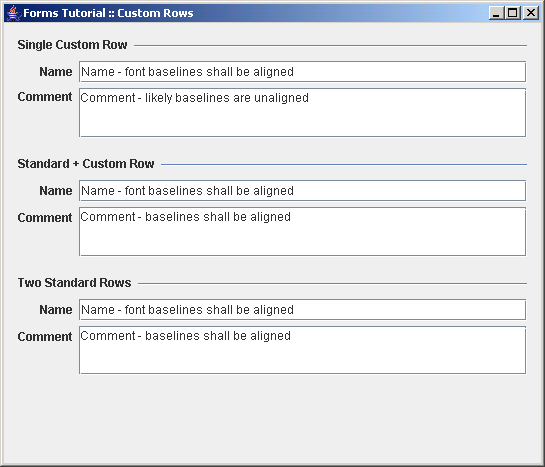Shows three approaches how to add custom rows to a form that is built
using a DefaultFormBuilder

/*
* Copyright (c) 2002-2004 JGoodies Karsten Lentzsch. All Rights Reserved.
*
* Redistribution and use in source and binary forms, with or without
* modification, are permitted provided that the following conditions are met:
*
* o Redistributions of source code must retain the above copyright notice,
* this list of conditions and the following disclaimer.
*
* o Redistributions in binary form must reproduce the above copyright notice,
* this list of conditions and the following disclaimer in the documentation
* and/or other materials provided with the distribution.
*
* o Neither the name of JGoodies Karsten Lentzsch nor the names of
* its contributors may be used to endorse or promote products derived
* from this software without specific prior written permission.
*
* THIS SOFTWARE IS PROVIDED BY THE COPYRIGHT HOLDERS AND CONTRIBUTORS "AS IS"
* AND ANY EXPRESS OR IMPLIED WARRANTIES, INCLUDING, BUT NOT LIMITED TO,
* THE IMPLIED WARRANTIES OF MERCHANTABILITY AND FITNESS FOR A PARTICULAR
* PURPOSE ARE DISCLAIMED. IN NO EVENT SHALL THE COPYRIGHT OWNER OR
* CONTRIBUTORS BE LIABLE FOR ANY DIRECT, INDIRECT, INCIDENTAL, SPECIAL,
* EXEMPLARY, OR CONSEQUENTIAL DAMAGES (INCLUDING, BUT NOT LIMITED TO,
* PROCUREMENT OF SUBSTITUTE GOODS OR SERVICES; LOSS OF USE, DATA, OR PROFITS;
* OR BUSINESS INTERRUPTION) HOWEVER CAUSED AND ON ANY THEORY OF LIABILITY,
* WHETHER IN CONTRACT, STRICT LIABILITY, OR TORT (INCLUDING NEGLIGENCE
* OR OTHERWISE) ARISING IN ANY WAY OUT OF THE USE OF THIS SOFTWARE,
* EVEN IF ADVISED OF THE POSSIBILITY OF SUCH DAMAGE.
*/
import javax.swing.*;
import com.jgoodies.forms.builder.DefaultFormBuilder;
import com.jgoodies.forms.layout.CellConstraints;
import com.jgoodies.forms.layout.FormLayout;
import com.jgoodies.forms.layout.RowSpec;
/**
* Shows three approaches how to add custom rows to a form that is built
* using a DefaultFormBuilder.<ol>
* <li> single custom row,
* <li> standard + custom row,
* <li> multiple standard rows.
* </ol>
* These differ in the position of the 'Comment' label, the alignment
* of font baselines and the height of the custom row.
*
* @author Karsten Lentzsch
* @version $Revision: 1.7 $
*
* @see DefaultFormBuilder
* @see DefaultFormWithCustomAreasExample
*/
public class DefaultFormWithCustomRowsExample {
private JTextField name1Field;
private JTextArea comment1Area;
private JTextField name2Field;
private JTextArea comment2Area;
private JTextField name3Field;
private JTextArea comment3Area;
public static void main(String[] args) {
try {
UIManager.setLookAndFeel("com.jgoodies.plaf.plastic.PlasticXPLookAndFeel");
} catch (Exception e) {
// Likely PlasticXP is not in the class path; ignore.
}
JFrame frame = new JFrame();
frame.setTitle("Forms Tutorial :: Custom Rows");
frame.setDefaultCloseOperation(WindowConstants.EXIT_ON_CLOSE);
JComponent panel = new DefaultFormWithCustomRowsExample().buildPanel();
frame.getContentPane().add(panel);
frame.pack();
frame.setVisible(true);
}
// Component Creation and Initialization **********************************
/**
* Creates and intializes the UI components.
*/
private void initComponents() {
name1Field = new JTextField("Name - font baselines shall be aligned");
name2Field = new JTextField("Name - font baselines shall be aligned");
name3Field = new JTextField("Name - font baselines shall be aligned");
comment1Area = new JTextArea(2, 20);
comment2Area = new JTextArea(2, 20);
comment3Area = new JTextArea(2, 20);
comment1Area.setText("Comment - likely baselines are unaligned");
comment2Area.setText("Comment - baselines shall be aligned");
comment3Area.setText("Comment - baselines shall be aligned");
}
// Building ***************************************************************
/**
* Demonstrates three different ways to add custom rows to a form
* that is build with a {@link DefaultFormBuilder}.
*
* @return the built panel
*/
public JComponent buildPanel() {
initComponents();
FormLayout layout = new FormLayout(
"right:pref, 3dlu, min:grow",
"");
DefaultFormBuilder builder = new DefaultFormBuilder(layout);
builder.setDefaultDialogBorder();
builder.setRowGroupingEnabled(true);
CellConstraints cc = new CellConstraints();
// In this approach, we add a gap and a custom row.
// The advantage of this approach is, that we can express
// the row spec and comment area cell constraints freely.
// The disadvantage is the misalignment of the leading label.
// Also the row's height may be inconsistent with other rows.
builder.appendSeparator("Single Custom Row");
builder.append("Name", name1Field);
builder.appendRow(builder.getLineGapSpec());
builder.appendRow(new RowSpec("top:31dlu")); // Assumes line is 14, gap is 3
builder.nextLine(2);
builder.append("Comment");
builder.add(new JScrollPane(comment1Area),
cc.xy(builder.getColumn(), builder.getRow(), "fill, fill"));
builder.nextLine();
// In this approach, we append a standard row with gap before it.
// The advantage is, that the leading label is aligned well.
// The disadvantage is that the comment area now spans
// multiple cells and is slightly less flexible.
// Also the row's height may be inconsistent with other rows.
builder.appendSeparator("Standard + Custom Row");
builder.append("Name", name2Field);
builder.append("Comment");
builder.appendRow(new RowSpec("17dlu")); // Assumes line is 14, gap is 3
builder.add(new JScrollPane(comment2Area),
cc.xywh(builder.getColumn(), builder.getRow(), 1, 2));
builder.nextLine(2);
// In this approach, we append two standard rows with associated gaps.
// The advantage is, that the leading label is aligned well,
// and the height is consistent with other rows.
// The disadvantage is that the comment area now spans
// multiple cells and is slightly less flexible.
builder.appendSeparator("Two Standard Rows");
builder.append("Name", name3Field);
builder.append("Comment");
builder.nextLine();
builder.append("");
builder.nextRow(-2);
builder.add(new JScrollPane(comment3Area),
cc.xywh(builder.getColumn(), builder.getRow(), 1, 3));
return builder.getPanel();
}
}
 forms.zip( 197 k)
forms.zip( 197 k)Related examples in the same category